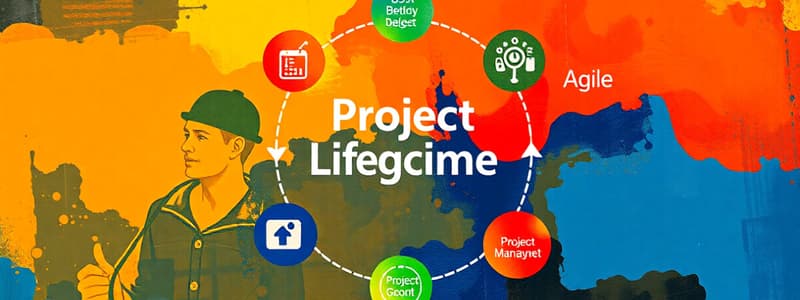Podcast
Questions and Answers
Which of the following best describes the primary purpose of a project charter?
Which of the following best describes the primary purpose of a project charter?
- To authorize the project manager and ensure a common understanding among stakeholders. (correct)
- To allocate resources across different project activities.
- To serve as a marketing document to attract potential investors.
- To define the detailed tasks and timelines for the project team.
In traditional project management, activities are performed iteratively, whereas in Agile, they are executed sequentially.
In traditional project management, activities are performed iteratively, whereas in Agile, they are executed sequentially.
False (B)
What are the three elements of the PMI Talent Triangle?
What are the three elements of the PMI Talent Triangle?
Technical, Leadership, and Strategic skills
A key purpose of defining the project scope is to set a foundation for planning and prevent scope ______.
A key purpose of defining the project scope is to set a foundation for planning and prevent scope ______.
Match the project role with its description:
Match the project role with its description:
Which of the following is NOT a typical element found in a project charter?
Which of the following is NOT a typical element found in a project charter?
A Work Breakdown Structure (WBS) mainly serves to ensure project completeness and helps in planning by hierarchically breaking down project deliverables.
A Work Breakdown Structure (WBS) mainly serves to ensure project completeness and helps in planning by hierarchically breaking down project deliverables.
Name two methods used for compressing project schedules.
Name two methods used for compressing project schedules.
In project scheduling, $\text{}$ and $\text{}$ are used to handle uncertain estimates. Using the provided content.
In project scheduling, $\text{}$ and $\text{}$ are used to handle uncertain estimates. Using the provided content.
Which activity is closely related to defining activities, according to the provided content?
Which activity is closely related to defining activities, according to the provided content?
Flashcards
What is a Project?
What is a Project?
A unique, time-bound effort to create a product or service that adds business value.
Project Management
Project Management
The application of knowledge, skills, tools, and techniques to project activities to meet the project requirements.
Project Skills
Project Skills
Technical skills specific to the project and soft skills like leadership and communication.
Project Life Cycle
Project Life Cycle
Signup and view all the flashcards
Project Selection & Types
Project Selection & Types
Signup and view all the flashcards
Traditional Executive Roles
Traditional Executive Roles
Signup and view all the flashcards
Traditional Managerial Roles
Traditional Managerial Roles
Signup and view all the flashcards
Traditional Associate Roles
Traditional Associate Roles
Signup and view all the flashcards
Agile Executive Roles
Agile Executive Roles
Signup and view all the flashcards
Agile Managerial Roles
Agile Managerial Roles
Signup and view all the flashcards
Study Notes
Chapter 1: Intro to Project Management
1.1 What is a Project?
- A project is a unique, time-bound endeavor with a distinct beginning and end.
- Every project aims to create a unique product or service to add business value.
- Stakeholders can either influence or be influenced by a project.
- Project Management is the application of knowledge, skills, tools, and techniques to achieve project goals.
1.2 History of Project Management
- Projects have occurred all throughout history.
- Formal project management started around the 1950s with emphasis on scheduling and control.
- The IT and telecom industries drove rapid growth in project management during the 1990s and 2000s.
- Recent trends include a greater focus on communication, leadership, teamwork, and Agile methodologies.
1.3 Project Work
- Projects are temporary, unlike operations, which are ongoing.
- Skills include hard (technical) and soft (leadership, communication) skills.
- The Project Life Cycle includes Initiating, Planning, Executing, and Closing.
- Agile approaches are iterative, adaptive, and flexible.
1.4 Understanding Projects
- PMI means Project Management Institute.
- PMBOK® means Project Management Body of Knowledge.
- The PMI Talent Triangle encompasses Technical, Leadership, and Strategic skills.
- Project Selection is based on goals, constraints, and success criteria.
- Project Types vary based on industry, size, and scope.
- Project tools should be scalable, using tailoring based on project complexity.
1.5 Project Roles
- Traditional Project Roles:
- Executive roles include Sponsor, Customer, Steering Team, and PMO.
- Managerial roles include Project Manager, Functional Manager, and Facilitator.
- Associate roles include Core Team Member and SME (Subject Matter Expert).
- Agile Roles:
- Executive roles include Customer (Product Owner), Sponsor, and Portfolio Team.
- Managerial roles include Scrum Master, Functional Manager, and Coach.
- Associate roles include Team Member.
1.6 Guide to the PMBOK 7th Edition
- ANSI/PMI 99-001-2021 Standard is the standard.
- It covers updated principles and guidelines for managing projects.
1.7 Agile
- Agile is iterative, while plan-driven such as traditional is sequential.
- Agile Manifesto Principles exist.
- Common Agile terms are relevant in project management.
Chapter 3: Project Charter
3.1 What is a Project Charter?
- A project charter represents an informal contract between the project team and the sponsor.
3.2 Project Charter Use
- A project charter authorizes the project manager, ensures common understanding, helps commitment, and screens out weak projects.
3.3 When is a Charter Needed?
- Decision Criteria which is based on project size and complexity.
3.4 Project Charter Elements
- Common elements: Title, Scope Overview, Business Case, Background, Milestone Schedule, Risks/Assumptions/Constraints, Resource Estimates, Stakeholder List, Team Operating Principles, Lessons Learned, Signatures/Commitment.
3.5 Constructing a Project Charter
- Collaboration: Ideally drafted by the team and approved by the sponsor.
- Scope Overview & Business Case should be a concise and clear statement.
- Milestone Schedule uses a table with key dates and evaluation criteria.
- Risk Analysis to identify and plan for risks.
- Resource Needs that estimate budget and staffing.
- The Stakeholder List prioritizes key stakeholders.
- Team Principles & Lessons Learned include guidelines for team collaboration.
- Signatures for formal approval.
3.6 Ratifying the Project Charter
- Discussion & Approval with sponsor and team before finalizing.
3.7 PMBOK Guide 7e
- Focus areas include stakeholders, team, development, planning, measurement, and uncertainty.
3.8 Agile Project Charters
- Agile terminology is used in project chartering.
Chapter 7: Scope Management & WBS
7.1 Plan Scope Management
- Defines how scope is managed.
- Product Scope outlines Features and functions.
- Project Scope outlines the work required.
7.2 Collect Requirements
- Ensure clarity in Objectives.
- Needs should be gathered from stakeholders using various methods.
- Needs must be defined as Requirements and traceability is key.
7.3 Define Scope
- Purpose is that defines foundation for planning and prevents scope creep.
- Steps:
- List deliverables and acceptance criteria.
- Establish project boundaries.
- Create a scope description.
7.4 Work Breakdown Structure (WBS)
- Definition represents a hierarchical breakdown of project deliverables.
- WBS ensures completeness and aids in planning.
- Formats of a WBS include indented outline, org chart, and free form.
- Work Packages are the lowest level, used for planning.
- Steps to Construct a WBS: Identify deliverables, decompose, review for completeness.
7.5 Establish Change Control
- Must manage and evaluate changes effectively.
7.6 PMBOK Guide 7e Domains
- Encompasses team, planning, delivery, measurement, and uncertainty.
7.7 Agile Projects
- Agile handles scope flexibly through prioritized backlogs.
7.8 Using MS Project for WBS
- Set up WBS using software tools.
Chapter 8: Project Scheduling
8.1 Plan Schedule Management
- PMI's 7 time management processes include defining, sequencing, and controlling activities.
8.2 Purposes of a Project Schedule
- Determine project completion date and track progress.
8.3 Historical Development
- PERT & CPM originally from the 1950s are now modern software tools.
8.4 How Schedules are Created
- Consider logical order, duration, resources, and constraints.
8.5 Define Activities
- Activities are derived from WBS work packages.
8.6 Sequence Activities
- Sequence activities with consideration of Leads & Lags, Dependency Types (FF, SS, SF).
8.7 Estimate Activity Duration
- When estimating activity duration, consider uncertainty, learning curves, and scheduling risks.
8.8 Develop Project Schedules
- Identify the Critical Path using forward/backward pass.
- Gantt Charts offer visual representation.
8.9 Uncertainty in Schedules
- PERT & Monte Carlo Simulations handle uncertain estimates.
8.10 Agile Scheduling
- Incorporate rolling wave planning and backlog prioritization.
Chapter 9: Resourcing and Scheduling Adjustments
9.1 Resourcing Skills
- Technical & Behavioral skills are required.
- The Science vs. Art of resource management matters.
9.2 Estimating Resource Needs
- Identify resource availability and constraints.
9.3 Plan Resource Management
- Use Resource Breakdown Structure (RBS).
9.4 Team Composition Issues
- Types of teams include Cross-Functional, Co-Located, Virtual, and Outsourced Teams.
9.5 Assigning Resources
- Use RACI Chart and Gantt Chart.
9.6 Resolving Resource Overloads
- Potential methods include reassigning work, delaying non-critical activities, or adding resources.
9.7 Compressing Schedules
- Crashing involves trading cost for time.
- Fast-Tracking involves trading risk for time.
9.8 Alternative Scheduling Methods
- Alternative methods include Critical Chain Project Management (CCPM), Reverse Phase Scheduling, and Rolling Wave Planning.
Studying That Suits You
Use AI to generate personalized quizzes and flashcards to suit your learning preferences.




